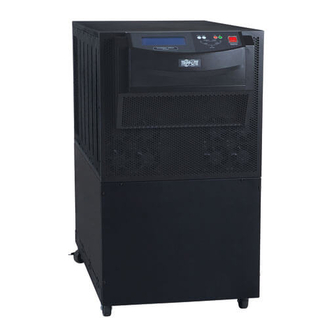Table of Contents
Advertisement
Quick Links
Extended-Run 3-Phase Battery Cabinet
Owner's Manual
Not suitable for mobile applications.
1111 W. 35th Street, Chicago, IL 60609 USA
+1.773.869.1234 • www.tripplite.com
Copyright © 2008 Tripp Lite. All trademarks are the sole property of their respective owners.
C
US
p. 2
p. 3
p. 5
p. 5
p. 5
p. 5
p. 6
p. 6
p. 6
p. 7
p. 7
p. 7
p. 8
p. 8
p. 8
p. 8
p. 8
p. 9
p. 9
p. 9
p. 10
p. 10
p. 11
p. 12
p. 13
p. 14
p. 15
p. 15
p. 15
p. 16
p. 16
Advertisement
Table of Contents

Summary of Contents for Tripp Lite 3-Phase Battery Cabinet Extended-Run
-
Page 1: Table Of Contents
7-2 Recommended Torque 8 – Storage and Service 9 – Warranty Copyright © 2008 Tripp Lite. All trademarks are the sole property of their respective owners. Owner’s Manual Not suitable for mobile applications. 1111 W. 35th Street, Chicago, IL 60609 USA +1.773.869.1234 •... -
Page 2: Introduction
1 – Introduction Tripp Lite’s Extended-Run 3-Phase Battery Cabinets connect to SmartOnline 3-Phase UPS Systems to provide long-lasting battery backup for data centers, telecommunications, networks, industrial facilities, security, emergency systems and other mission-critical applications that require high capacity, high availability and extended runtime. -
Page 3: Important Safety Instructions
2 – Important Safety Instructions SAVE THESE INSTRUCTIONS All sections of this manual contain instructions and warnings that must be followed during the installation and operation of the battery cabinet described in this manual. Read ALL instructions thoroughly before attempting to move, install or connect your battery cabinet. - Page 4 Allow batteries to charge uninterrupted for 24 hours after installation. • Do not attempt to service the integrated battery charger (included with “C” models only). Contact Tripp Lite if service is required. These symbols may appear on the product label:...
-
Page 5: Battery Cabinet Installation
4. If the battery cabinet includes an integrated battery charger (“C” models only), examine the wires at the DC output terminal closely. If any of the leads are bent or otherwise damaged from shipping, contact Tripp Lite. Damaged leads could cause a battery short circuit. -
Page 6: Internal Wiring (Typical)
3 – Battery Cabinet Installation 3-4 Internal Wiring (Typical) • Battery cabinets use multiple 6 VDC or 12 VDC batteries connected in series to provide nominal DC voltages ranging from 240 VDC to 480 VDC. • Internal cabling is sized for specific application load currents. The insulated cables can be 2 AWG, 4 AWG, 2/0 AWG, 4/0 AWG or dual 2/0 AWG. -
Page 7: Electrical Connection
3 – Battery Cabinet Installation 3-7 Electrical Connection DANGER! LETHAL HIGH VOLTAGE HAZARD! All wiring should be performed by a qualified electrician, in accordance with the warnings in this manual and all applicable electrical and safety codes. Incorrect wiring may cause serious personal injury and property damage. -
Page 8: Operation And Charging
4 – Operation and Charging 4-1 Determine Charging Voltages To determine the appropriate equalization (freshening) charge voltage and float charge voltage, multiply the number of batteries connected in series in the battery cabinet by the recommended charging voltage per unit. For example: A +/- 240 VDC cabinet containing 40 each of the UPS12-400MR batteries in series would use the following charging voltages: Freshening/Equalization Charge Voltage = 20 x 14.4 VDC/unit average= +/- 288 VDC... -
Page 9: Maintenance
5 – Maintenance The battery cabinet contains valve-regulated recombinant lead-acid (VRLA) batteries, which are maintenance-free relative to the electrolyte. You cannot add water to these batteries or sample the electrolyte specific gravity. It is necessary, however, to periodically check the charging voltage, temperature and connections of the individual battery units. 5-1 Maintenance Schedule Quarterly Check 1. -
Page 10: Diagrams
6 – Diagrams 6-1 Battery Cabinet Diagram (4 Shelves) 4.38 Breaker Mounting Plate 8.25 24.75 2.25 11.75 15.75 Side View Front View Side View 40.25 30.25 Top View Front of Cabinet Conduit Knockouts Front of Cabinet Conduit Knockouts 17.25 34.5 Side View Bottom View Side View... -
Page 11: Battery Cabinet Diagram (3 Shelves)
6 – Diagrams (continued) 6-2 Battery Cabinet Diagram (3 Shelves) 3.25 Side View Front of Cabinet Side View Note: All dimensions are inches. Top View Breaker 8.25 Mounting Plate 10.25 Front View Conduit Knockouts 14.5 Bottom View [11] 2.25 15.75 Side View Conduit Knockouts... -
Page 12: Battery And Breaker Diagrams (240 Vdc)
6 – Diagrams (continued) 6-3 Battery and Breaker Diagrams (240 VDC) Shelf 2 Shelf 3 Shelf 1 (Bottom) To Fuse or Breaker Termination Notes: • All internal wiring is UL-listed, MTW, 125C Hi-Flex cable. • Terminal block is UL-recognized and rated for 600 VDC. •... -
Page 13: Battery And Breaker Diagrams (+/- 240 Vdc)
6 – Diagrams (continued) 6-4 Battery and Breaker Diagrams (+/- 240 VDC) Shelf 4 (Top) Shelf 3 Shelf 2 Shelf 1 (Bottom) To Fuse or Breaker To Center Tap Termination Termination Notes: • All internal wiring is UL-listed, MTW, 125C Hi-Flex cable. •... -
Page 14: Battery Charger (Select Models)
6 – Diagrams (continued) 6-5 Integrated Battery Charger (Select Models) 6.25 Terminal Block Detail Notes: • All dimensions are inches. • AC input is selectable 120/208/240 VAC, 60 Hz. • Constant voltage output. • Electronic current limiting and high voltage shutdown. •... -
Page 15: Specifications
7 – Specifications 7-1 Dimensions and Floor Loading Battery Cabinet Model BP240V99 BP240V120 BP240V1207C BP240V150 BP240V1507C BP480V55 BP480V78 BP480V103 BP480V140 BP348V55 BP348V78 BP348V103 BP348V150 7-2 Recommended Torque Battery Cabinet Model BP240V99 BP240V120 BP240V1207C BP240V150 BP240V1507C BP480V55 BP480V78 BP480V103 BP480V140 BP348V55 BP348V78 BP348V103 BP348V150... -
Page 16: Storage And Service
Regulatory Compliance Identification Numbers For the purpose of regulatory compliance certifications and identification, your Tripp Lite product has been assigned a unique series number. The series number can be found on the product nameplate label, along with all required approval markings and information. When requesting compliance information for this product, always refer to the series number.











